Wyandotte Chicken: Complete Breed Guide
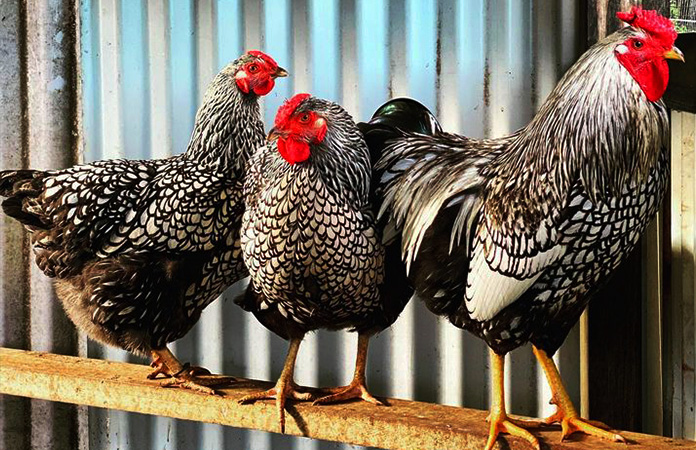
Wyandotte chickens are an American chicken breed. They are ideal for both meat and egg production and are considered an excellent option for beginners. The most popular color in Wyandotte chickens is the Silver Laced, but together with the experts of the Dutch Wyandotte Club, we have explored all possible colors and characteristics of this beautiful breed.
Let’s discuss all there is to know about these beauties.
- Wyandotte hens lay 200 eggs per year
- Easy to care for
- Cold- hardy chicken breed
- Friendly but assertive
- Easily go broody
- 200 Large Eggs Yearly
- Kept for Both Meat and Eggs
- Very Cold-Hardy
- Dominant Towards Other Breeds
- Not Fond of Hot Temperatures
- Need More Coop Space
Characteristics
The Wyandotte chicken is relatively large, medium in height, but quite rounded. The hens weigh around 6,5 pounds (2,9kg), and roosters are tipping the scale at roughly 8 pounds (3,6kg). There is also a Bantam miniature version available. All Wyandottes have nice, full, and rounded breasts, which makes them great meat chickens next to their excellent egg-laying capabilities.
| Eggs | 200 eggs/year |
| Egg Color | Brown |
| Egg Size | Large |
| Weight | 6.5 – 8 lbs |
| Hardiness | Cold |
| Temperament | Friendly but assertive |
| Beginner-friendly | Yes |
| Color | Nine recognized colors in the The Standard |
Their legs are clean and yellow-skinned. Wattles, earlobes, and faces are red. Wyandottes typically have a rose comb on their rather broad skull.
Wyandottes come in various colors or patterns. In the US, nine colors are recognized in ‘The Standard’ of the American Poultry Association. In Europe, thirty colors are listed. So, whatever color or pattern you prefer, the Wyandotte probably has one that matches your taste.
The first recognized color variety was the Silver Laced Wyandotte, a stunning white bird with black lacing, which gives a black scalloped pattern all over its body. It’s also the most popular color variety in this breed.
All other colors or pattern varieties originate from the silver-laced Wyandotte.
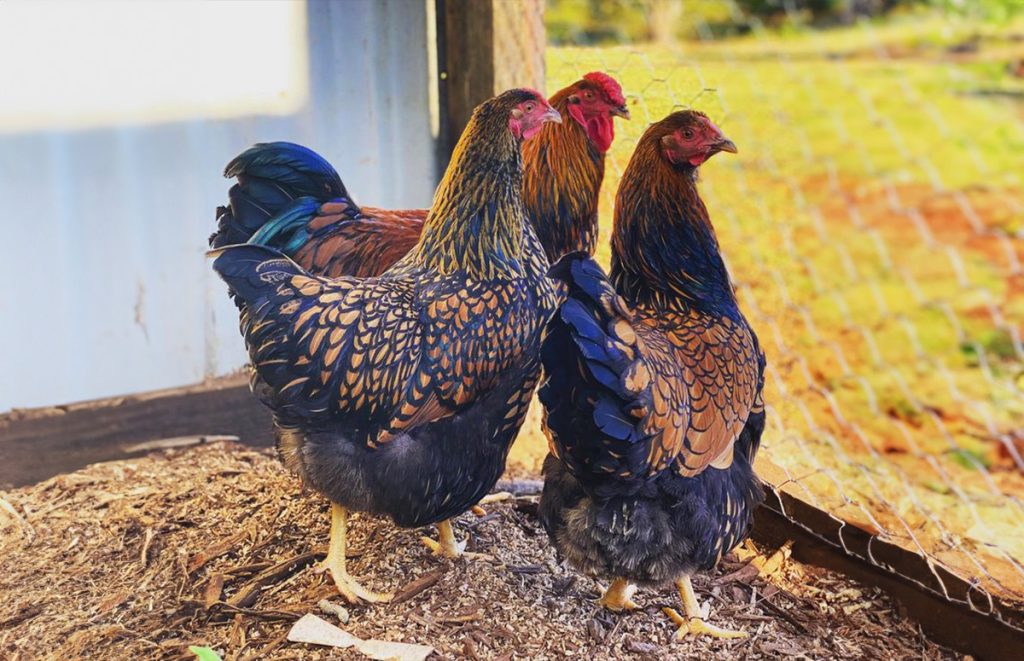
Common color patterns on the Wyandotte chicken, next to the Silver Laced, are Golden Laced, Blue Laced Red, Silver Penciled, Black, White, Partridge, and Buff. But also less common varieties, such as the Splash Laced Red, are stunning.
Because the Wyandotte is a reasonably large and heavy chicken, it can not fly or jump very high. They’ll jump up to the roosting bar but not over high fences. This makes them docile, as they won’t escape as quickly as ‘flighty’ breeds such as Marans.
So they won’t bother your neighbors with a surprise visit, which is an advantage when living in a suburban neighborhood.
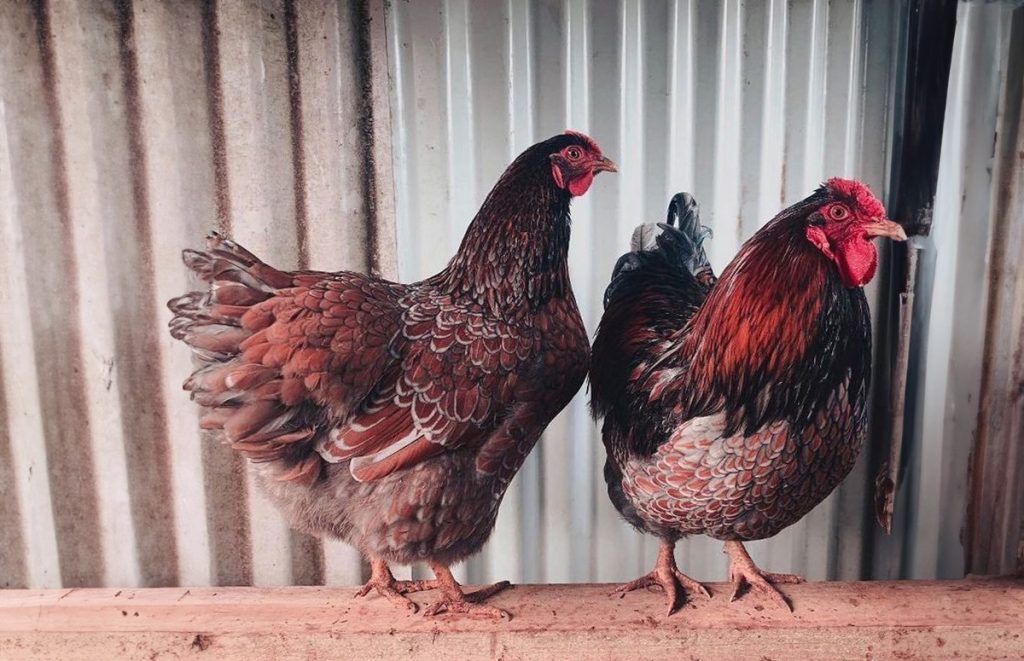
Bantam
The Wyandotte Bantams made it into the Standard of Perfection of the American Poultry Association since 1933. They are listed with the same color patterns as the large fowl, but there is also a buff Columbian variation.
The roosters weigh 26-30 ounces, whereas the hens weigh about 25 ounces. That’s much less than the large fowl. They are miniature chickens, and like all Bantams, they consume less food and need less space.
Climate
Wyandottes are quite hardy chickens that thrive well in cold environments. They’ve been bred especially to withstand cold American winters with their small rose comb and fluffy body.
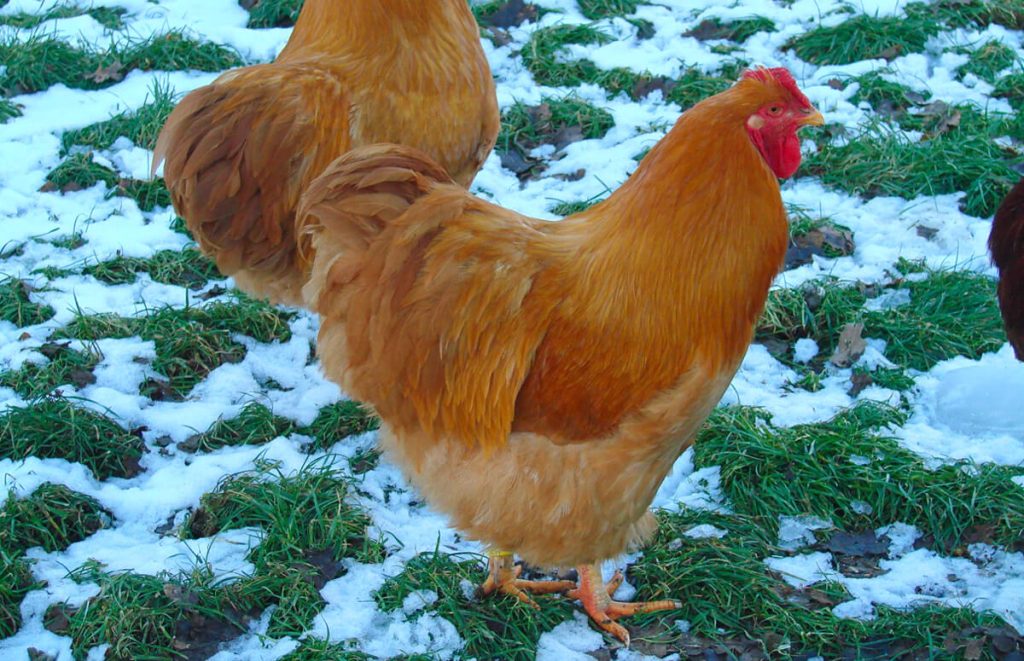
On the other hand, Wyandottes don’t like tropical temperatures. So when dealing with a heat wave, always ensure to keep them cool, and provide much-needed shade and fresh water. Wyandottes are not the best breed to keep in a Mediterranean or southern climate because of their body structure and comb size. They’ll quickly overheat and suffer heat stress.
If you’re living in a tropical environment, the Wyandotte chicken is not the best breed for you to keep. Instead, go for Mediterranean breeds or chickens with larger combs, like the Sicilian Buttercup or the Ancona. But remember, all animals need extra care during extreme weather.
Wyandotte Hen vs Rooster
Most Wyandotte chickens are not sex-linked, which means you have to wait a couple of months after hatching to be sure whether you have a hen or a rooster on your hands. The only exception is the Barred Wyandotte, as the barred gene is sex-linked.
Barred Wyandottes, however, are not that common, so in most cases, your Wyandotte won’t show its sex until around five months old.
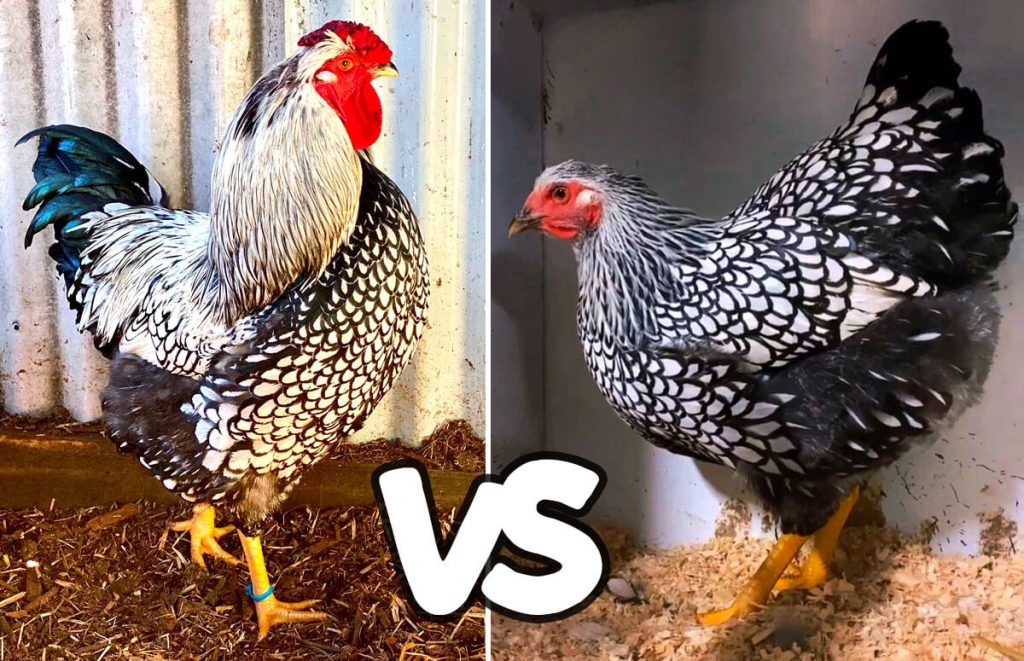
Both male and female Wyandottes have almost the same feather pattern. They also share other characteristics like the color of their head, wattles, and comb.
Sexing young Wyandottes for their gender can be somewhat tricky as they are not sex-linked. But that doesn’t mean there are no differences. Here are the main differences between Silver Laced hens and roosters.
| Feature | Wyandotte Rooster | Wyandotte Hen |
|---|---|---|
| Weight | 8 lbs | 6.5 lbs |
| Back | Pointed saddle feathers | Rounded feathers |
| Plumage | Patchy (cockerels) | Uniform lacing (pullets) |
| Tail Feathers | Long sickles, pointed, no lacing | Laced, shorter, rounded on the edges |
| Comb, Wattles | Big, red | Small, pink |
| Body | Large and broad with long legs | Smaller, shorter legs |
Roosters tend to grow faster and develop slightly more pronounced and reddish wattles and combs, while those of hens are more pink. Also, roosters typically have a sturdier build and longer legs than their female counterparts.
You can tell their gender with certainty around the age of five months. If you want to learn more about the different kinds of feathers, check out our feather guide.
Personality
Wyandottes make great backyard chickens. They are kind and friendly to humans and children, although they are not ‘lap chickens’ like Silkies or Frizzle Chickens.
A Wyandotte will love to keep you company when working in the garden. But because of their size, they need enough space inside the chicken run or let them free range. They won’t wander too far and will find their way home at dusk. They are active birds and love to roam around.
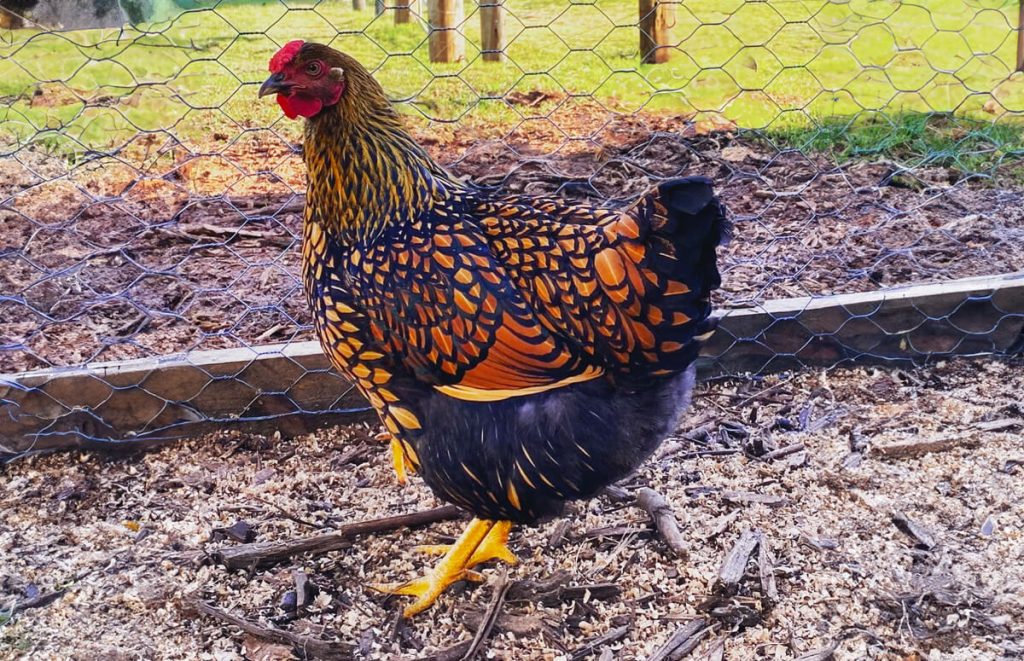
As friendly as they are to humans, as dominant they can be to other birds. They do have a temperament! Wyandottes are mostly high in the pecking order as they are assertive chickens. You can keep Wyandottes with other chicken breeds without any problems, but try choosing other friendly but assertive breeds to join them, like Rhode Island Reds or Plymouth Rocks.
It’s best not to mix Wyandottes with small or submissive breeds, like Silkies, Orpingtons, or Faverolles. Wyandottes are not aggressive, but the roosters protect their flock very seriously.
In short, if you want to add a Wyandotte to a mixed flock, make sure their personalities match to prevent bullying.
Egg Production
A Wyandotte chicken is a perfect dual-purpose breed. The hens lay around four large brown eggs per week, that’s more than 200 eggs per year. A Wyandotte hen keeps laying during winter, although egg production can decrease. The only time Wyandottes stop laying eggs is during molting.
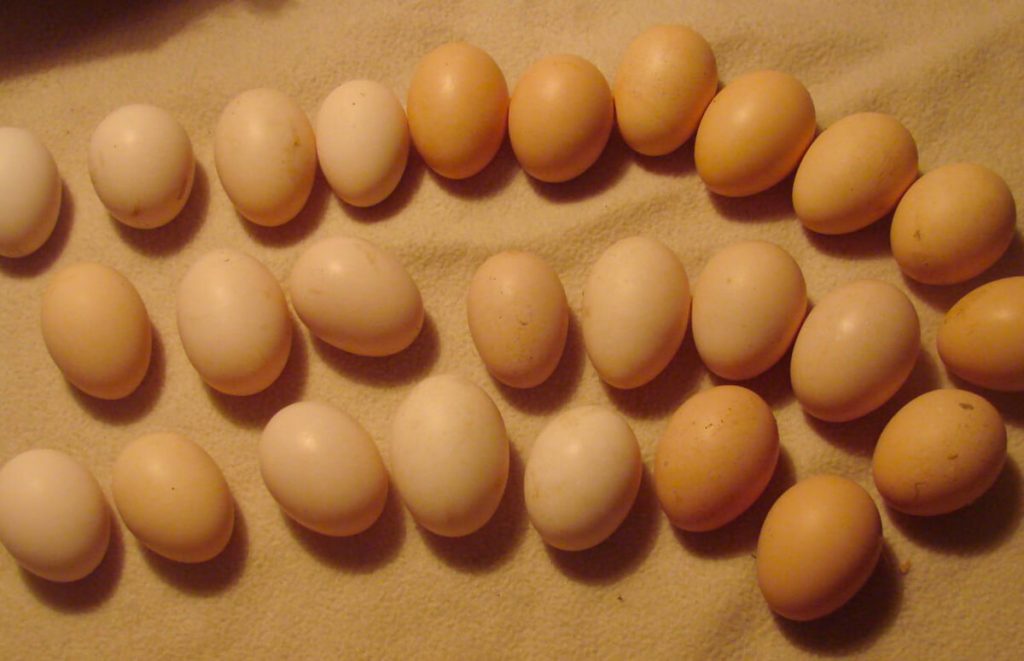
Wyandotte hens make excellent mothers. They tend to go broody quite easily, which is something to keep in mind when you’re not planning to hatch eggs. Broodiness can weaken a hen and make them temporarily stop egg production.
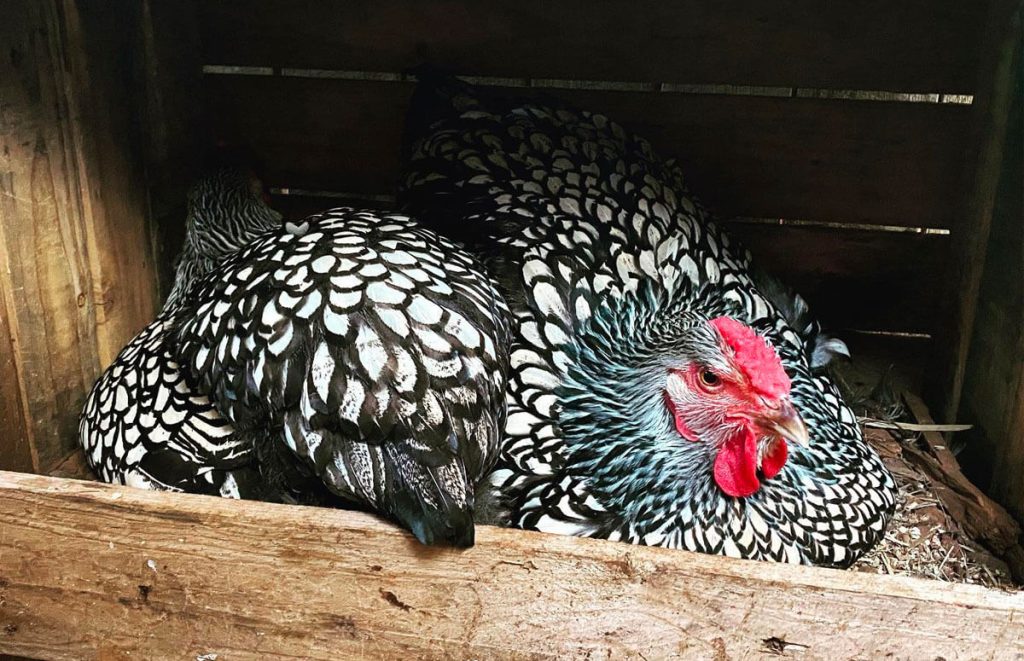
Pros and Cons of the Wyandotte
The Wyandotte is a breed cherished by many chicken keepers but has pros and cons. Let’s address the most important ones.
Let’s start with the pros. On the positive side, these chickens excel in cold climates. They are equipped with small rose combs and fluffy bodies, which make them remarkably resilient to chilly temperatures.
Additionally, their striking plumage adds an ornamental touch to any flock. They are the perfect dual-purpose breed, known for both egg production and meat quality. Wyandottes are also excellent foragers, reducing the need for extra commercial feeding.
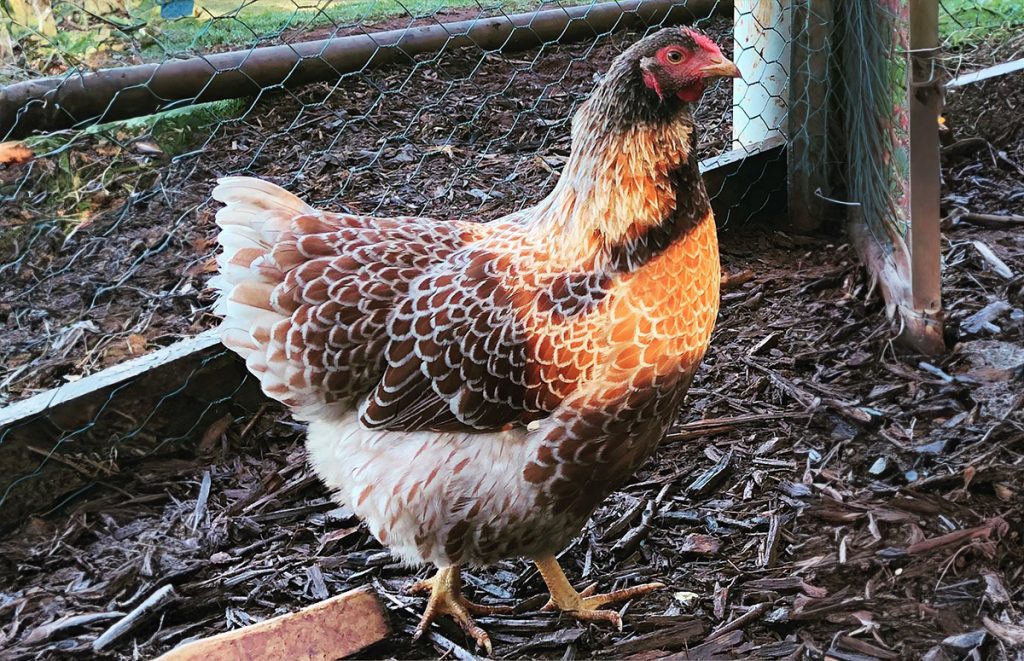
However, they need more space than other breeds. Next, despite their cold-hardy nature, they do not fare well in warmer climates. Additionally, Wyandottes are a dominant breed, which can result in conflicts if you keep a mixed flock. It’s best not to keep them together with submissive breeds.
| Pros – Reasons to choose for Wynadottes | Cons – Reasons to go for another breed |
|---|---|
| Cold-hardy Excellent foragers Dual purpose breed Beautiful color Don’t need much extra care Friendly towards people & children | Need more space Dominant towards smaller breeds Don’t do well in warm climates Other breeds lay more eggs – average layers They are no lap chickens Tend to go broody |
History of the Wyandotte Chicken
The Wyandotte finds its origin in the 1870s in the US. This chicken was bred especially to survive cold American winters and to create a dual-purpose breed. The Silver Laced Wyandotte was the first official color variation, gaining recognition in the American Standard of Perfection in 1883.
The first breed varieties went by various names referring to black-and-white Sebrights, like Sebright Cochin or American Sebright. Afterward, they renamed this breed ‘Wyandotte’ after the ‘Wyandot’ tribe, a Native American tribe in North America.
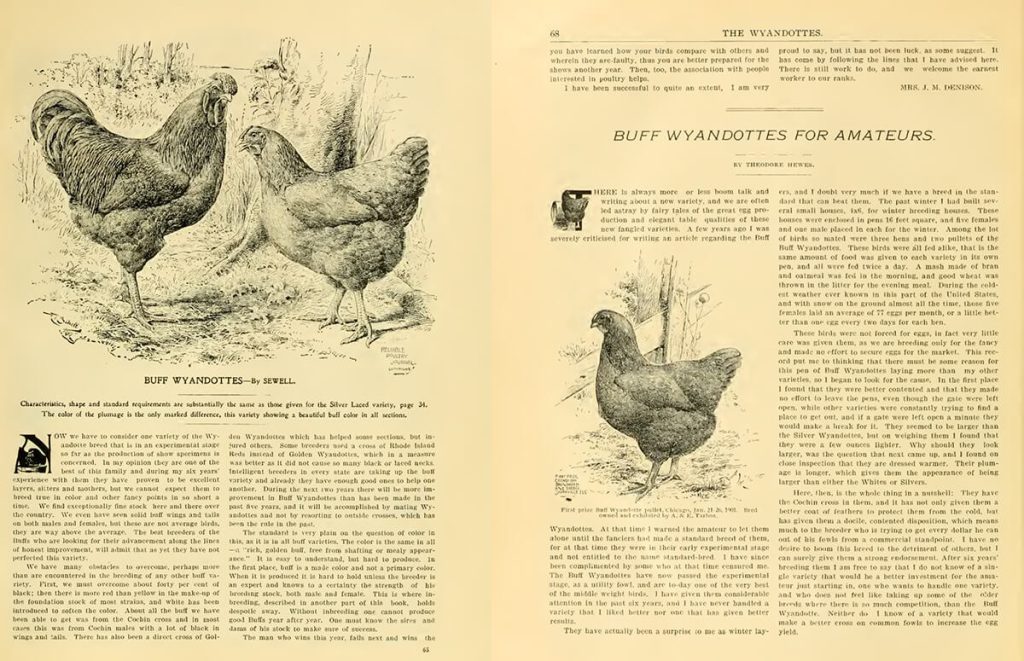
The origin of the Silver Laced Wyandotte remains a mystery, but according to Livestock Conservancy, it is believed to result from breeding efforts involving spangled Hamburgs and dark Brahmas. The Hamburg’s contribution is seen in the breed’s rose comb, making them well suited for colder climates.
Wyandotte Color Varieties
The Wyandotte chicken breed has many color varieties, including the Silver and Golden Laced variety (also called Gold Laced), but also Silver penciled and White. While only nine official Wyandotte color varieties are described in The Standard of the American Poultry Association, the Europeans have thirty colors listed.
In general, Wyandottes come in three classes:
- Laced Wyandottes: silver laced, golden laced, blue laced, …
- Marked Wyandottes: black-white Columbia, Silver Penciled, …
- Single-colored Wyandottes: black, white, blue, buff, …
Let’s go over the most important color varieties of the Wyandotte chicken
Silver Laced Wyandotte
The Silver Laced Wyandotte is an iconic variety of the Wyandotte chicken breed with silvery-white plumage and dark, intricate lacing. Silver Laced Wyandottes are the first variety of Wyandottes and have especially been bred since 1870 to stand cold American winters.
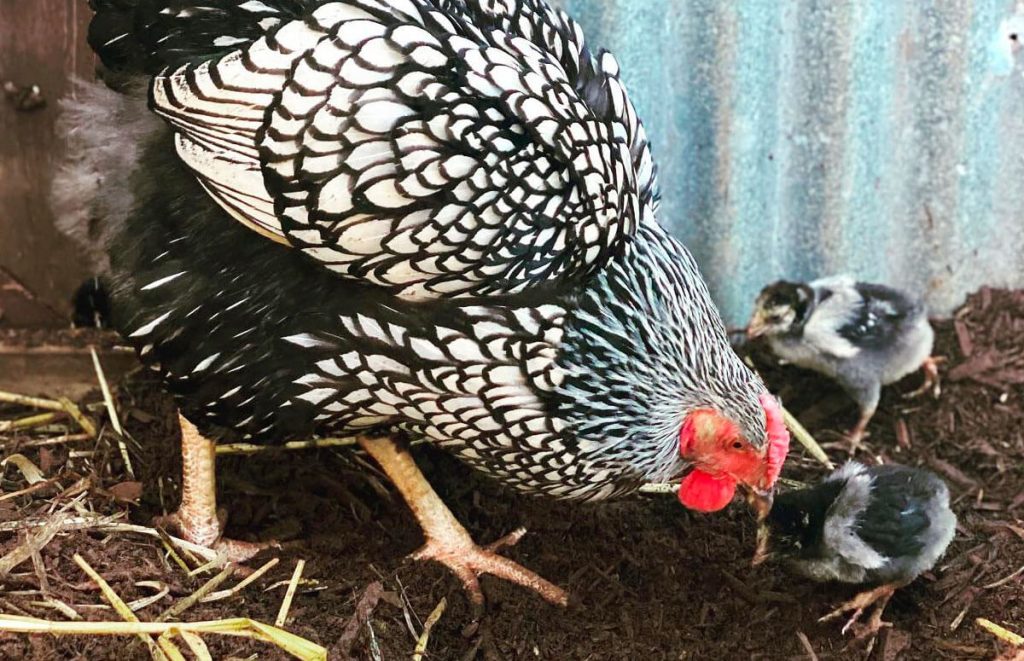
Basically, the pattern is the result of two effects:
- the silvery-white ground color
- the black lacing
The Silver Laced Wyandotte is white because its DNA contains the Silver gene (S). This sex-linked gene is located on the Z chromosome. Roosters carry two copies of the S-gene, hens only one. So a Silver Laced Rooster can carry some gold (suppressed by the S-gene), but a hen can’t hide any gold if it’s white.
Silver Penciled Wyandotte
The Silver Penciled Wyandotte and the Silver Laced Wyandotte are both visually striking varieties within the Wyandotte breed. The primary difference between the two varieties lies in the arrangement of markings on their feathers.
The Silver Laced Wyandotte is a white chicken with a wide black lacing on its feathers. The Silver Penciled Wyandotte has multiple nested lines instead of single lacing, which results in an entirely different pattern. The penciling consists of fine, parallel lines of black and white. The base color of the feathers is white.
The black lines of the penciling pattern in Silver Penciled Wyandottes result from the “Pattern gene” (Pg). This gene arranges the black pigments in concentric lines on the feather, keeping the outer lace in its natural color.
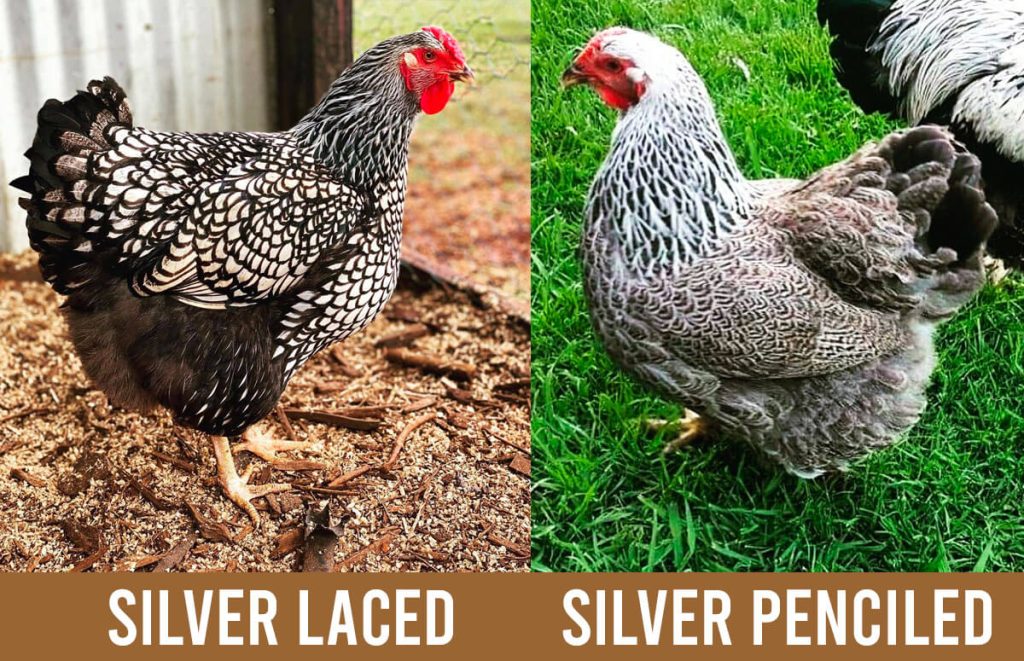
The Silver Penciled pattern is the result of two effects:
- the silvery-white base color
- the black penciling pattern
Two New York breeders, George Brackenbury and Ezra Cornell, played a significant role in creating the Silver Penciled Wyandotte. They initiated a breeding program that crossed several chicken breeds, including Partridge Wyandottes, Dark Brahmas, Silver Laced Wyandottes, and Silver Penciled Hamburgs.
In 1902, the Silver Penciled Wyandotte variety was officially admitted to the American Standard of Perfection.
Golden Laced Wyandotte
The Golden Laced Wyandotte has a golden plumage with beautiful black lacing. The roosters are more brownish, while the hens exhibit a redder mahogany brown color. The base color of their feathers is brown, and the lacing is black.
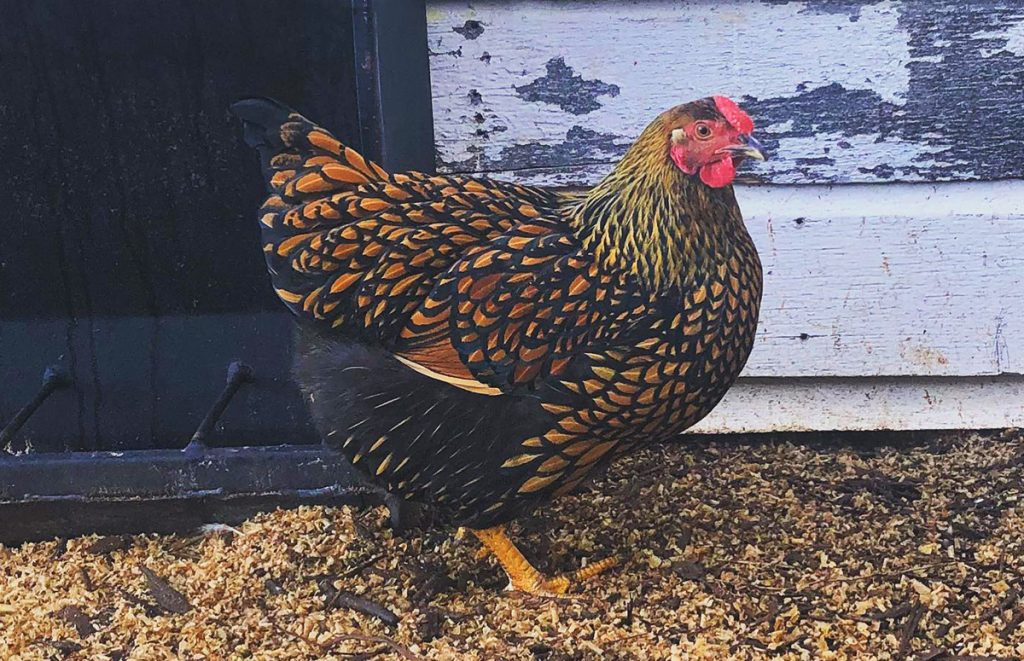
After the Silver Laced color variety was created, the Golden Laced Wyandotte was produced by breeding these Silver Laced Wyandotte hens with Gold-Spangled Hamburg and Partridge Cochin roosters.
Golden lacing was the second color ever on Wyandottes and is still common among breeders today.
One of the advantages is that Golden Laced Wyandottes breed true. If you cross a Golden Laced Hen and Golden Laced Rooster, the offspring is also Golden Laced. This is not the case for other variants, like the Blue Laced Red, as the blue gene does not breed true.
Blue Laced Red Wyandotte
The name Blue Laced Red Wyandotte describes its coloration: a beautiful mix of reddish-brown feathering and blue lacing. Blue Laced variants don’t have a blue (greyish) body. Only their lacing is blue, which makes things utterly confusing.
This color is not recognized by the APA, but is a recognized color in Europe.

The Buff Laced and Blue Laced varieties were first observed around 1897, emerging from the crossings of Gold Laced and White Wyandottes. The blue is comparable to the blue in the Blue Andalusian.
Basically, the Blue Laced Red pattern in Wyandottes is the result of two effects:
- the brown to mahogany red ground color
- the greyish blue lacing
The greyish color of the lacing comes from the Blue gene, which dilutes the black pigments in the feather. Chickens that have a single copy of the Blue gene (Bl bl+) look greyish. Birds with two copies (Bl Bl) look Splash or almost white.
Splash Laced Silver Wyandotte
Splash Laced Silver Wyandotte is the same as the Blue Laced Silver Wyandotte, but these birds have two copies of the Blue-gen. This fades away almost all of the black lacing, turning the birds to almost white. It is not an official recognized color variety.
The key difference between blue and splash lacing in Wyandottes lies in the color of the lacing. Blue lacing is a more vibrant gray or violet, while splash lacing is pale gray or almost white.
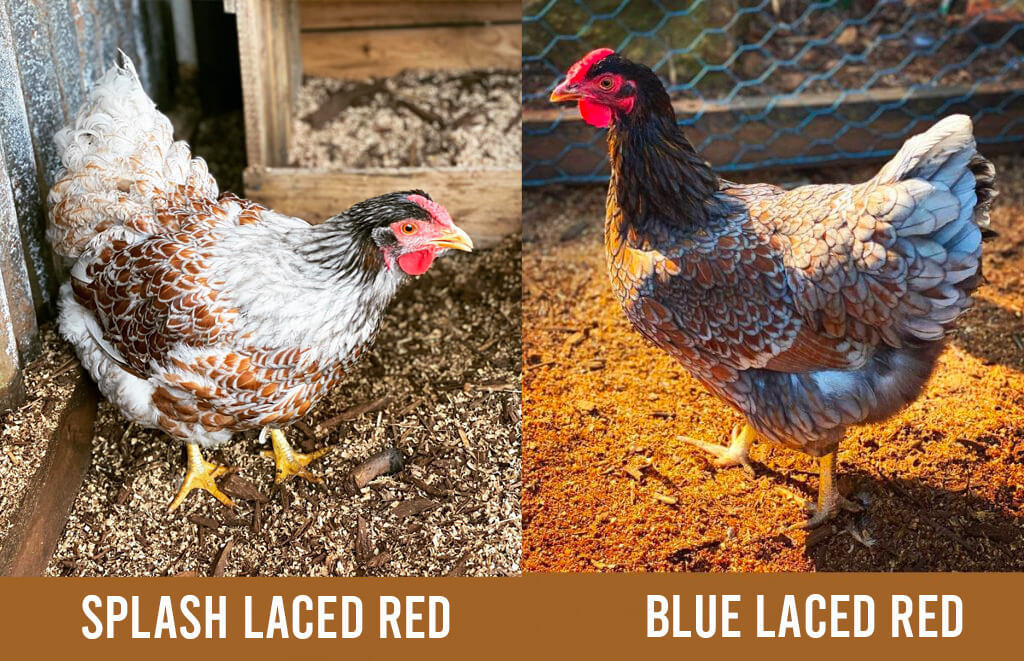
The Splash Laced Red pattern in Wyandottes is the result of two effects:
- the yellow-brown to mahogany-red ground color
- the pale greyish lacing
Splash Laced Red Wyandottes are Wyandotte chickens with two copies of the blue gene. They are a common by-product of breeders trying to breed the Red Laced Wyandottes that only carry a single blue gene.
If you don’t have Splash lacing in your flock, you can create Splash Laced Wyandottes by crossing Blue Laced Reds. Crossing two Blue Laced Red Wyandottes gives you 25% Black Laced Wyandottes, 50% Blue Laced Wyandottes, and 25% Splash Laced Wyandottes.
Columbia
The “Columbia” variety is a specific color pattern in Wyandottes. Columbia Wyandottes typically have white feathers with blue-black lacing, which gives them a distinctive appearance.
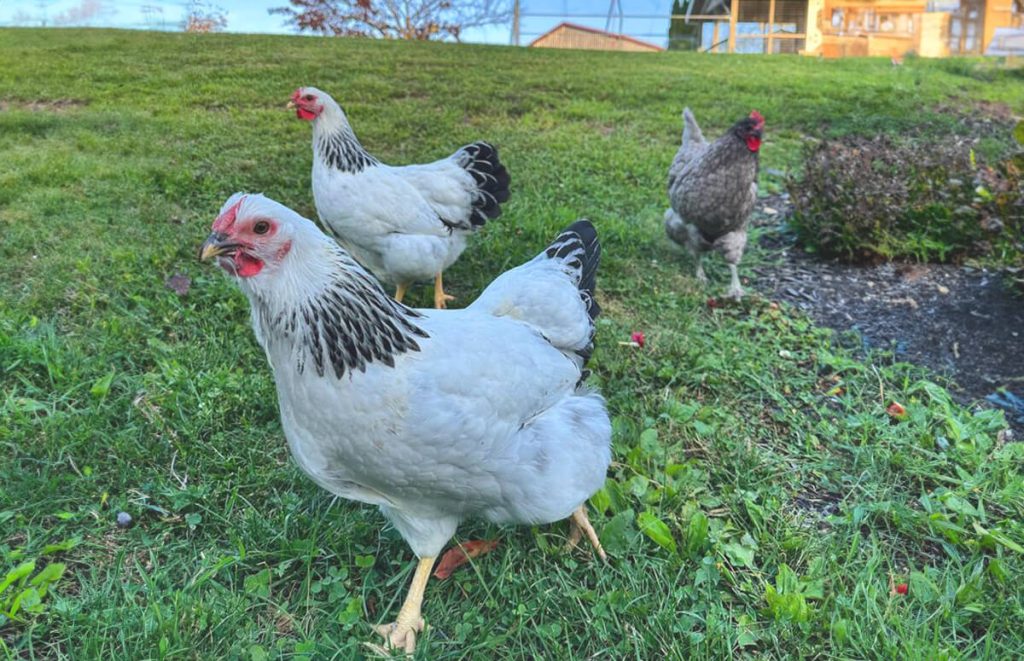
The looks of the Columbian Wyandotte are mainly the result of two genetic effects:
- the silvery-white ground color
- the black Columbian markings
The Columbian pattern is caused by the Columbian (Co) gene. It restricts the black pigments on the backs, wings, saddle, and parts of the tail.
The Columbian Wyandotte is a variety developed due to selective breeding and was created by B.M. Briggs in 1893. Its name honors the Columbian Exposition and World’s Fair, which took place in Chicago, Illinois, that same year. Mr. Briggs began his work with White Wyandottes and the Barred Rock, focusing on breeding for the specific Columbian pattern.
The creator made it very clear that no Light Brahma blood was used in developing this strain of Columbian Wyandotte, which was often the case in developing other Wyandotte varieties.
White
As the name implies, the most noticeable feature of the White Wyandotte is its snow-white plumage. This immaculate color is observed all over their body, with no other colors involved.
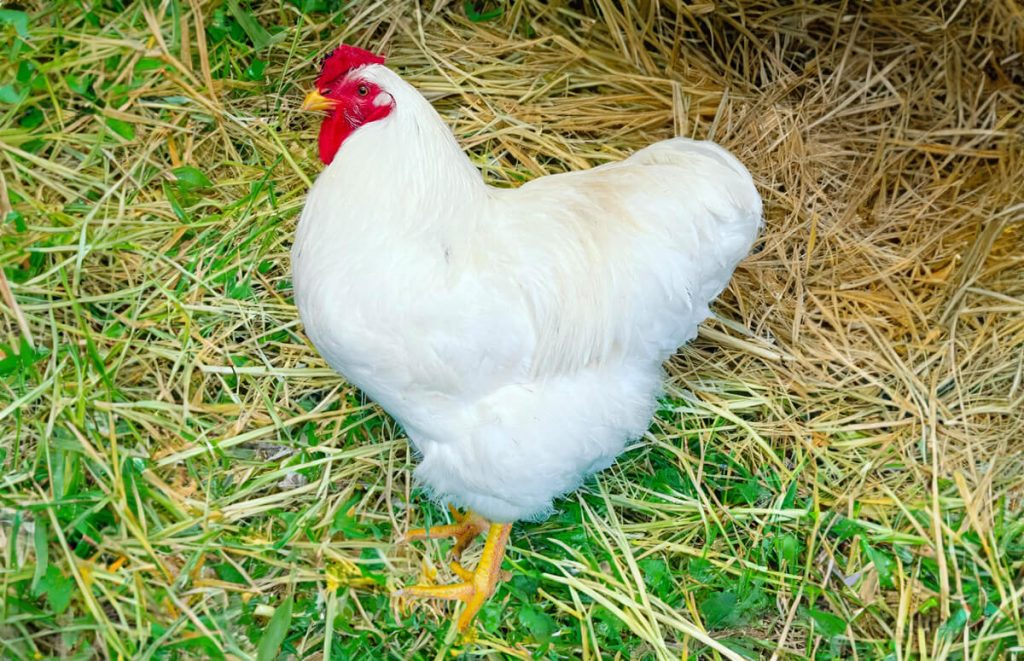
White Wyandottes are a “sport” that appeared as a genetic mutation in the breeding of Silver Laced Wyandottes, which led to the creation of a new variety with white plumage. White Wyandottes were standardized on the same date as the Golden Laced, in 1888.
White Wyandottes are white because they lack any black or red pigments. These pigments are suppressed by the recessive white genes, also known as colorless c or cc. This genetic mutation originally diverged the White Wyandotte from its parent variety, the Silver Wyandotte.
Buff
Another example of a single-colored variety is the Buff Wyandotte. The yellow-brown color of the Buff Wyandottes is the ground color of the chicken, without any patterns or black pigmentation.
The single-colored Wyandottes, like the Black, White, and Buff Wyandotte, are less popular among breeders and chicken enthusiasts. The laced and penciled varieties are much more popular. Moreover, the title for the most popular buff-colored breed goes to the Buff Orpington.
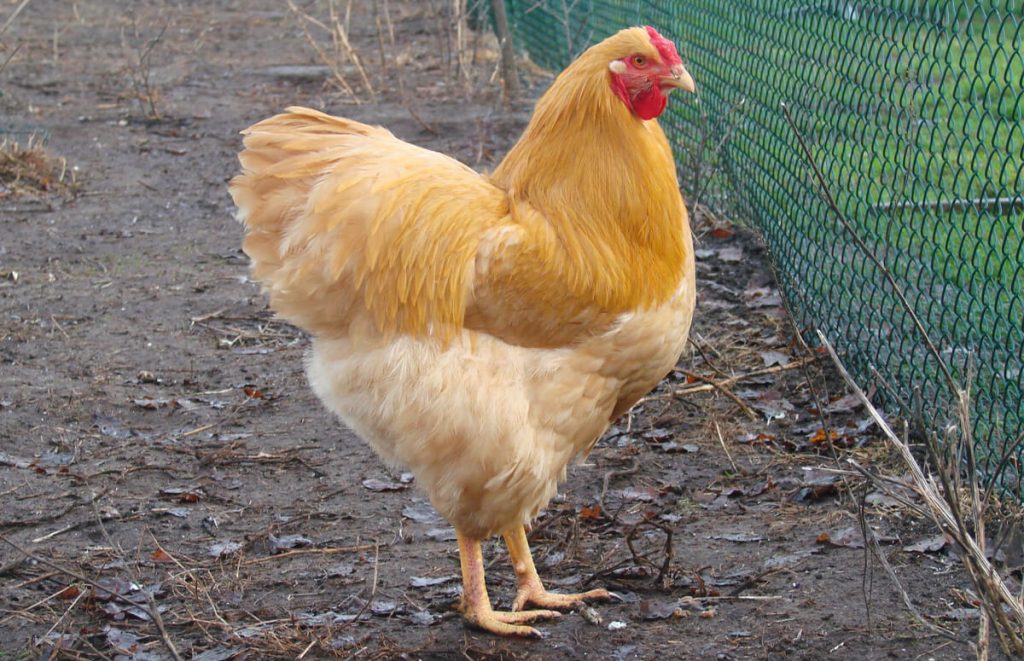
Several dedicated US-based breeders played a significant role in shaping the Buff Wyandotte into the breed we know today. Breeders experimented with various combinations to achieve the desired characteristics, and the results were often achieved by crossing Rhode Island Reds with Silver Laced Wyandottes, Golden Laced Wyandottes with White Wyandottes, and Golden Laced Wyandottes with Buff Cochins.
In 1893, the Buff Wyandotte received official recognition when admitted to the American Standard of Perfection.
There is also the Buff Laced Wyandotte, which has the same buff ground color but white lacing on the feathers. This variety looks much more like the Blue Laced Red Wyandotte, but with a yellow ground color.
Wyandotte Chicken Breeding
Silver lacing was the first color in the standards and is still the most common among breeders today.
One of the advantages is that Silver Laced Wyandottes breed true. If you cross a Silver Laced Hen and Silver Laced Rooster, the offspring will also be Silver Laced. This is not the case for other variants, like the Blue Laced Red, as the blue gene does not breed true.
Silver Laced Wyandottes often captivate newcomers at exhibitions, where breeders and judges frequently engage in conversations beside the cages. Although widely bred nowadays, they are relatively infrequently showcased, as it’s difficult to get the color and lacing perfect.
Crossing a Silver Laced Wyandotte with a Golden Laced Wyandotte
The Golden Laced Wyandotte has a gold ground color with black lacing. In this cross, the results are all about the Silver gene. The Silver gene makes the ground color white. Birds without Silver look gold.
The silver gene is sex-linked on the Z chromosome of a chicken. Roosters have two Z-chromosomes (ZZ), and hens only have one (ZW). Silver is dominant, so if a Rooster has a single copy (S s+), it will be white.
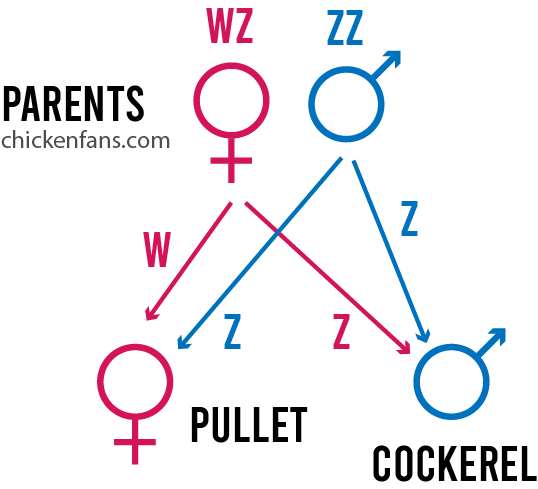
The following table lists all the possible outcomes for the cockerels and pullets in the offspring when you cross a Silver Laced Wyandotte with a Gold Laced bird.
| Rooster | Hen | Rooster Offspring | Hen Offspring |
|---|---|---|---|
| Golden Laced (s+s+) | Silver Laced (S-) | Silver Laced (Ss+) | Golden Laced (s+-) |
| Silver Laced (SS) | Golden Laced (s-) | Silver Laced (Ss+) | Silver Laced (S-) |
| Silver Laced carrying Gold (Ss+) | Golden Laced (s+) | Silver Laced (Ss+) Golden Laced (s+s+) | Silver Laced (S-) Golden Laced (s+-) |
| Silver Laced carrying Gold (Ss+) | Silver Laced (S-) | Silver Laced (SS) Golden Laced (Ss+) | Silver Laced (S-) Golden Laced (s+-) |
Summary
To learn more about chicken breeds, check out our ‘Chicken Breeds Page‘ to see every specific breed we address. Or go to our listicle breed summary on ‘The Classroom‘, or, if you’re unsure where to start, take a look at our ‘Chicken Breeds: Ultimate Beginners Guide‘.
Related Articles
Here are some of the articles we mentioned:
- Silver Laced Wyandotte: a breed profile of the Silver Wyandotte variety
- Silver Penciled Wyandotte: a breed profile of the Silver Penciled Wyandotte variety
- Golden Laced Wyandotte: a complete guide of the Golden Laced Wyandotte chicken
- Buff Wyandotte: a complete guide of the Buff Wyandotte chicken and buff varieties
- Blue Wyandotte: a complete guide of the Blue Wyandotte chicken and blue varieties
- Blue Laced Red Wyandotte: a comprehensive guide on this interesting variety
- Splash Laced Red Wyandotte: a guide on the Splash Laced Red variety
- White Wyandotte: a breed profile of the White Wyandotte
- Sebright Chickens: a chicken breed that has varieties with a similar lacing pattern
- Brahma Chickens: large chicken breed originally used to create the Wyandotte
- Hamburg Chickens: chicken breed used to create the Wyandotte, with similar black and white patterns
- Chicken Feather Guide: to understand the difference between all types of feathers
- Chicken Breeding & Genetics: an overview for chicken breeding and genetics for beginners
If you are considering to get Silver Laced Wyandottes, here are some other resources:
- Chicken Coop Size Calculator: to calculate the size of your coop
- Chicken Raising Guide: general chicken raising guide
Credits for the photos and special thanks go to Cactus Hill Poultry breeders, specializing in breeding silver-laced wyandottes.






















